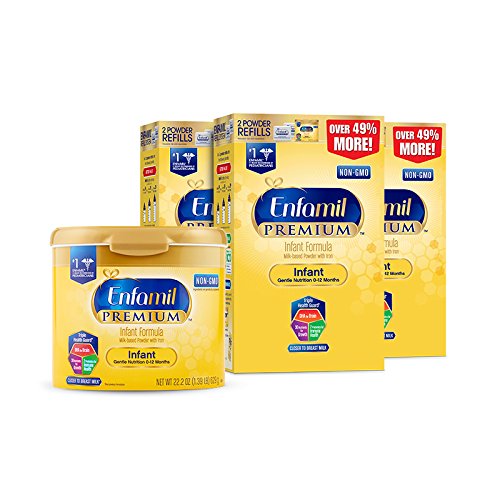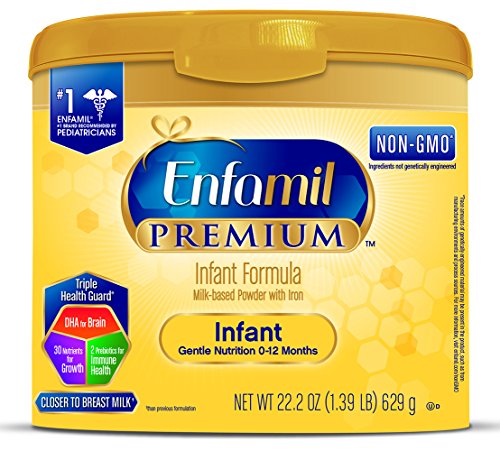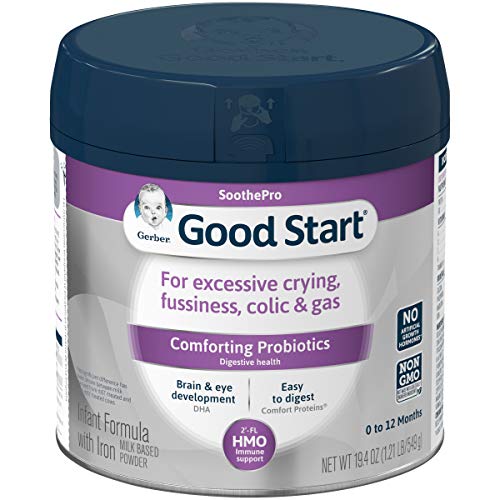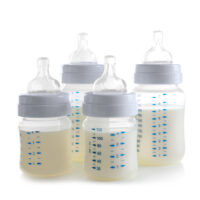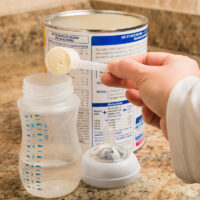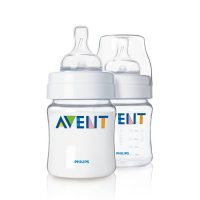Editor’s Note
As of May 2022, many formulas have become increasingly difficult to find. Please read our article, What To Do If You Can’t Find Baby Formula, for more information regarding the formula shortage.
Baby formula is the next best alternative to breast milk, but which is the right one for your baby?
It’s time to choose an infant formula for your little one, and you’re absolutely overwhelmed by the numerous choices that are available. A great starting point would be to consider Gerber Good Start and Enfamil. They provide the nourishment and nutrients your growing baby needs. Both Good Start and Enfamil are great alternatives to breast milk. I prefer Enfamil’s Gentlease because it is the only formula that reduced my infant’s colic symptoms.
Read Enfamil or Similac if you are interested in how Similac compares as well.
Gerber Good Start and Enfamil in a Nutshell
Gerber is “a baby’s best friend.” It is obvious that the company has done its best to develop formulas with all the required nutrients. Not only that, but they offer 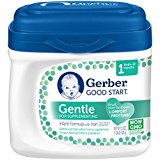 options to reduce fussiness, digestive issues, and CMPA. I, however, had difficulty in preparing their powdered formula; it clumped together and didn’t completely dissolve in water. Also, this formula has a kind of fishy odor despite not affecting the overall taste.
options to reduce fussiness, digestive issues, and CMPA. I, however, had difficulty in preparing their powdered formula; it clumped together and didn’t completely dissolve in water. Also, this formula has a kind of fishy odor despite not affecting the overall taste.
Did I mention that all Gerber formulas are non-GMO? This is a huge win for Good Start!
Although my little one loved both Gerber and Enfamil formulas, she was a colicky baby who needed something easier to digest. During this phase, she instantly took a liking to Enfamil Gentlease, so I switched to solely using it. As a working mother who traveled a lot, carrying loose formula was a “big no” for me. The Enfamil single-serve packages were a lifesaver. You could say that convenience and tolerability made the choice easy. I’m not a fan of their GMO formula options, however. 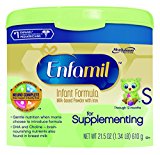
Overall, I believe that Gerber Good Start and Enfamil are equivalent in regards to providing the nutrients required for growth. In addition, both companies offer a variety of formulas for nearly every infant feeding problem.
It’s always a good idea check out all of the formulas just in case there is one that addresses your infant feeding issues. Let’s quickly review all of the options, and the key ingredients in each.
Gerber Good Start
Gerber is a well-known brand baby food brand, so it’s no surprise that many parents would trust their infant formula. One benefit is that it’s much more affordable than other formulas on the market. Best of all, it is free of genetically engineered ingredients.
Gerber has created a product line with formulas for different infant and toddler ages. Labels indicate Stage 1, Stage 2, and Stage 3 based on age. They include:
- Stage 1: Birth to 12 months
- Stage 2: 6 – 12 months
- Stage 3: 12 – 24 months
The company offers nine different formulas to address a variety of infant needs, and has recently updated their packaging. For mothers who are breastfeeding their infants but need to supplement, there is Gerber Good Start Gentle Supreme stage 1 formula. Because of the A2 cow’s milk proteins, Gerber claims that it is much easier for babies to digest. It is fortified with iron to prevent anemia, and compensate for the reduced absorption of iron from infant formulas (source).
For babies who are solely formula fed, there is the newly labelled Gerber Good Start GentlePro. This is their primary “closest to breast milk” option. It’s very similar to Good Start for supplementing moms, except it has 2-FL HMO and probiotics added. According to Gerber, it is the only formula with a blend of docosahexaenoic acid (DHA), prebiotics and probiotics. DHA is a fatty acid that helps with vision, brain, and overall body development.
Gerber has a six to 12 month formula for babies who have begun to eat pureed foods. As an infant breastfeeds over the first year of life, the composition of breastmilk changes (source). Good Start GentlePro 2 attempts to simulate that next phase of breastmilk, or Stage 2. This versiondiffers from the Stage 1 formula in its ratio of proteins, carbohydrates, fats, and other ingredients.
Gerber also has a sensitive tummy line known as Good Start SoothePro. It too has the proprietary blend of DHA, prebiotics, and probiotics. Many babies have immature digestive tracts, and develop tummy issues. SoothePro contains the colic-reducing probiotic L.reuteri. In addition, it has a broken down form of whey protein to ease fussiness and gassiness.
For families who prefer a plant-based diet, or babies with galactosemia, Gerber has Good Start Soy Stage 1 infant and Stage 3 toddler formulas. These are made with soy proteins, and are totally lactose and milk-free.
***For infants with a cow’s milk protein allergy, there is Gerber Good Start Extensive HA, Stage 1 formula. The proteins are hydrolyzed even more than those of Gerber SoothePro to prevent an infant’s immune system from reacting. As with any formula change, always consult a doctor to be sure that you are making the right decision for your little one.
Enfamil
Enfamil is a leading baby formula brand that’s often available in hospital newborn nurseries. It’s priced a little higher than other brands on the market, but, if it suits your baby, then it’s well worth it.
Like Gerber, Enfamil has formula versions for different infant and toddler ages. For example, you will find:
- Newborn stage: 0-3 months
- Infant stage: 0 – 12 months
- Toddler stage 2 & 3: Enfagrow 9 months – 3 years
Enfamil Enspire, for newborns to 12 month olds, closely mimics breastmilk. It includes all of the “good stuff” such as MFGM, lactoferrin, prebiotics, probiotics, essential vitamins, and, best of all, only lactose as the sweetener instead of a corn-based ingredient. Lactoferrin is a breastmilk protein that has anti-infection properties. Colostrum, the pre-milk is high in lactoferrin. Milk-fat globule membrane (MFGM) is important for cognitive development and boosting the immune system. Because of these “designer” ingredients, Enfamil Enspire is more expensive than other formulas. It is also only available as a non-GMO option.
Enfamil Reguline is for infants who suffer from constipation. It contains a prebiotic blend that is “clinically proven” to promote healthy digestion and softer stools. In addition, Reguline has partially hydrolyzed proteins which are also easier to digest. Like other Enfamil products, this formula has the same great nutrients, so overall, a win-win.
Enfamil A.R. is a formula for infants who have painful reflux or excessive spit-ups. Its composition includes the company’s patented Natural DefenseDual Prebiotics Blend for digestive health. The added rice starch thickens the formula, helping it to stay inside of baby’s stomach. This option is much safer than adding rice cereal to a bottle of regular infant formula which can be a choking hazard for younger babies (source).
Enfamil’s Enfamil ProSobee is their soy protein, plant-based option. Although parents may choose it to reduce gassiness and fussiness caused by milk-based formulas, it is not the American Academy of Pediatric’s first choice. They only recommend soy formula for babies with galactosemia, congenital lactose intolerance, or a diarrheal infection. For fussy, gassy babies, Enfamil Gentlease can be a “lifesaver” for mothers with its easy-to-digest, partially hydrolyzed proteins. It provides all-around nutrition without the bloating or gassiness.
with Enflora LGGis for babies with a CMPA . Like Gerber Good Start Extensive HA formula, the smaller protein particles help with digestion, and prevent allergic symptoms. It also contains the key formula nutrients that promote optimal brain and vision development.
Pros
Good Start:
- non-GMO formula
- Many options for changing babies needs
- Affordable
- Has a liquid concentrate version to which water must be added
- Some contain probiotic and prebiotics
Enfamil:
- Has non-GMO options
- A variety of options for babies with gastrointestinal issues
- Single-serve packets for ease of use while traveling
- Some contain prebiotics, lactoferrin, and MFGM
Cons
Good Start:
- Preparation is difficult (i.e. clumping)
- Sometimes has a fishy odor
- Packaging quality issues when delivered by mail
Enfamil
- Expensive
- Has GMO versions
- Packaging quality issues when mail-delivered
Reviews
Good Start:
4.6 stars,136 reviews – Walmart.com
4.8 stars, 92 reviews – Target.com
4.6 stars, 146 reviews – Walgreens.com
Enfamil:
4.5 stars, 667 reviews – Walmart.com
4.5 stars, 659 reviews – Target.com
4.4 stars, 636 reviews – Walgreens.com
What you need to know about formula
Infant formula is a healthy alternative to breast milk. With advancements in research, formula companies have found ways to mimic many of the components of breast milk to promote the growth and development of your little one.
The Food and Drug Administration (FDA) regulates all baby formula that is sold in the U.S. They ensure that any formula on the market provides adequate nutrition. The basic ingredients must include minerals, vitamins, proteins, fats, and carbohydrates per the international ESPGHAN regulations. These standards guarantee that the products are also free of pathogens, tested for final nutrient content, and can support infant growth and weight gain.
With the FDA’s backing, the following types of formula are available for purchase:
- Powdered form (must be mixed with water before feeding)
- Ready-to-feed (requires no mixing and is ready to drink)
- Liquid concentrate (requires mixing with equal amounts of water)
So what should you give your baby?
Honestly speaking, both formula brands are equally good. Since they are FDA approved, you know they are safe and appropriate for your baby. Some formulas may include “a few extras” that increase the price. The choice is completely up to you.
At many times, the decision depends on your little one. Despite having similar ingredients, your baby may prefer one formula more than the other. If price is not an issue, there is no harm trying an Enfamil non-GMO option. I’m a strong believer in non-GMO foods (a personal preference) which is why I love that all of Good Start formulas are non-GMO.
Gerber Good Start Gentle Powder Infant formula is the more “pocket-friendly” option. It contains lactose as a sweetener which is similar to breastmilk. Taste-wise and composition-wise, Good Start is a solid infant formula option.
